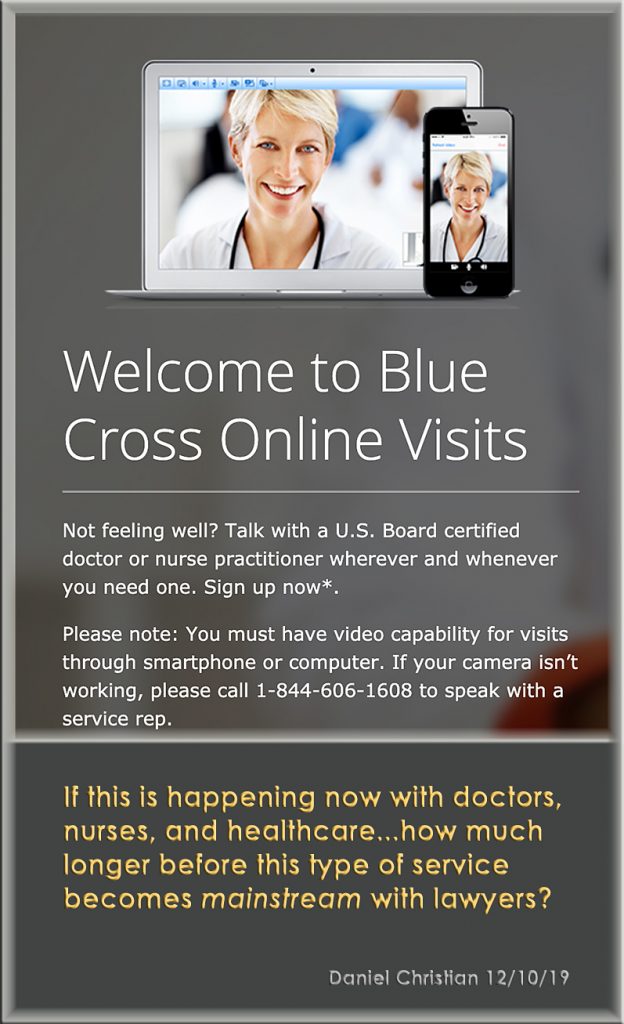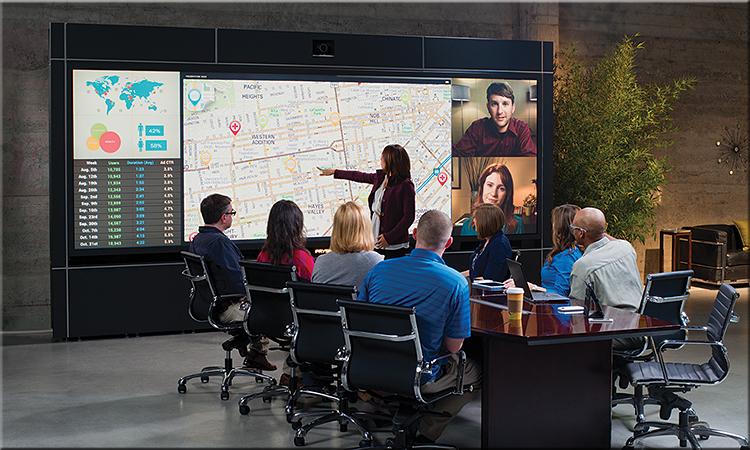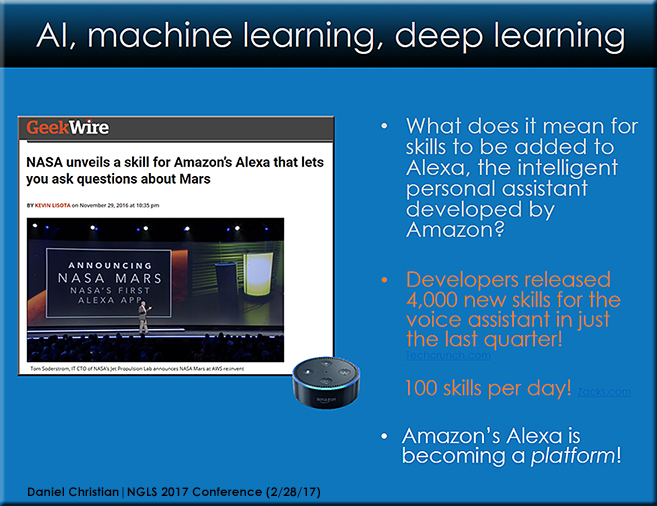From DSC:
Though we aren’t quite there yet, the pieces continue to come together to build a next generation learning platform that will help people reinvent themselves quickly, efficiently, constantly, and cost-effectively.






From DSC:
Along these lines, we’ll likely see more bots and virtual legal assistants that we will be able to ask questions of.
#A2J #AccessToJustice #legal #lawyers #society #legaltech #bots #videoconferencing #AI #bots #VirtualAssistants
Along these lines, also see:
Innovative and inspired: How this US law school is improving access to justice — from studyinternational.com
Excerpt:
Though court and other government websites in the US provide legal information, knowing what to search for and understanding legal jargon can be difficult for lay people.
Spot, software that is being developed at the LIT Lab, aims to fix this.
“You know you have a housing problem. But very few people think about their housing problems in terms of something like constructive eviction,” explains David Colarusso, who heads the LIT Lab. “The idea is to have the tool be able to spot those issues based upon people’s own language.”
Developed by Colarusso and students, Spot uses a machine-based algorithm to understand legal queries posed by lay persons. With Spot, entering a question in plain English like “My apartment is so moldy I can’t stay there anymore. Is there anything I can do?” brings up search results that would direct users to the right legal issue. In this case, the query is highly likely to be related to a housing issue or, more specifically, to the legal term “constructive eviction.”
Lastly, here’s an excerpt from INSIGHT: What’s ‘Innovative’ in BigLaw? It’s More Than the Latest Tech Tools — from news.bloomberglaw.com by Ryan Steadman and Mark Brennan
Top Innovation Factors for Success
Before revving the engines in the innovation process, the safety check comes first. Successful innovation requires a deliberate, holistic approach that takes into consideration people, process, and technology. Firms and vendors that listen and learn before implementing significant change will stand apart from competitors—and help ensure long-term success.
Think you could learn Mandarin? This Kansas kindergarten classroom is Chinese-only — from by Robert Smith
Excerpts:
In a Wolf Springs Elementary School classroom with “Chinese Only Zone” signs taped to the walls, kindergarteners are learning their core subjects in the primary language of a global economic superpower located across the world.
This language-immersion class of kindergarteners is part of a new Blue Valley School District initiative to graduate high school seniors fluent in a second language, an asset school officials believe will give students a leg up as they pursue academics and careers and prepare students to participate in a global workforce.
…
Chinese Mandarin, a group of dialects spoken by more than 800 million people, is a tonal language in which the meaning of words can be reflected by voice pitch. Though its grammar is similar to English, words or phrases are represented by Chinese characters.
Besides the usual educational stresses, parents who put their children in the program would need to be committed to the program. Because these kindergarteners are expected to remain together in a Mandarin-speaking classroom all the way through high school, new immersion students can only enter the program in kindergarten.
…
While other elementary-aged students spend roughly 60 minutes studying Spanish per week, this group of kindergartens spends half of their school time each day with Pan learning math, science and social studies in Mandarin. The groups studies reading and literacy with teacher Haley Watkins in English.
“In under a minute we filled all of the slots. That afternoon we had hundreds of people on the waiting list.”
From DSC:
Wow! This is quite the K-12 cohort/immersion! Add to that type of setup tools like Cisco Webex, Blackboard Collaborate, Adobe Connect, etc. — and not to mention what happens with virtual reality in the next decade — and this type of cohort/immersion will likely be highly effective over time.
So what will the future classrooms of the world look like? My guess is that with 5G and virtual reality on the way, there will be a lot more “connections” being made in the future…with many nations/classrooms being involved.

[From my purchase of iStock #1154674846.]

Internet of Things in the World of School— from datafloq.com
Excerpt:
In this blog post, we’ll discuss the benefits of the IoT for education — the sphere that remains farther to the background in terms of the IoT application but can benefit from it at all stages. Besides, schools are meant to prepare students for entry into the adult world. As the IoT changes the landscape of their futures, it is crucial to change the space where students spend their formative years.
DC: I would add the ability of electric doors & elevators to know when an approved Double Robotics Telepresence Robot is approaching & then open the door &/or be able 2assist in getting the device to its destination on campus.
See: https://t.co/w3olOFsHNUhttps://t.co/2uEM8C5HST pic.twitter.com/FuEZgTpeCO— Daniel Christian (@dchristian5) September 27, 2019
Cisco and American Well are teaming up to let you talk to your doctor from your TV — from cnbc.com by Christina Farr
Key points:
From a fairly recent e-newsletter from edsurge.com — though I don’t recall the exact date (emphasis DSC):
New England is home to some of the most famous universities in the world. But the region has also become ground zero for the demographic shifts that promise to disrupt higher education.
This week saw two developments that fit the narrative. On Monday, Southern Vermont College announced that it would shut its doors, becoming the latest small rural private college to do so. Later that same day, the University of Massachusetts said it would start a new online college aimed at a national audience, noting that it expects campus enrollments to erode as the number of traditional college-age students declines in the coming years.
“Make no mistake—this is an existential threat to entire sectors of higher education,” said UMass president Marty Meehan in announcing the online effort.
The approach seems to parallel the U.S. retail sector, where, as a New York Times piece outlines this week, stores like Target and WalMart have thrived by building online strategies aimed at competing with Amazon, while stores like Gap and Payless, which did little to move online, are closing stores. Of course, college is not like any other product or service, and plenty of campuses are touting the richness of the experience that students get by actually coming to a campus. And it’s not clear how many colleges can grow online to a scale that makes their investments pay off.
“It’s predicted that over the next several years, four to five major national players with strong regional footholds will be established. We intend to be one of them.”
University of Massachusetts President Marty Meehan
From DSC:
That last quote from UMass President Marty Meehan made me reflect upon the idea of having one or more enormous entities that will provide “higher education” in the future. I wonder if things will turn out to be that we’ll have more lifelong learning providers and platforms in the future — with the idea of a 60-year curriculum being an interesting idea that may come into fruition.
Long have I predicted that such an enormous entity would come to pass. Back in 2008, I named it the Forthcoming Walmart of Education. But then as the years went by, I got bumbed out on some things that Walmart was doing, and re-branded it the Forthcoming Amazon.com of Higher Education. We’ll see how long that updated title lasts — but you get the point. In fact, the point aligns very nicely with what futurist Thomas Frey has been predicting for years as well:
“I’ve been predicting that by 2030 the largest company on the internet is going to be an education-based company that we haven’t heard of yet,” Frey, the senior futurist at the DaVinci Institute think tank, tells Business Insider. (source)
I realize that education doesn’t always scale well…but I’m thinking that how people learn in the future may be different than how we did things in the past…communities of practice comes to mind…as does new forms of credentialing…as does cloud-based learner profiles…as does the need for highly efficient, cost-effective, and constant opportunities/means to reinvent oneself.
Also see:
Addendum:
74% of consumers go to Amazon when they’re ready to buy something. That should be keeping retailers up at night. — from cnbc.com
Key points (emphasis DSC)
“In New England, there will be between 32,000 and 54,000 fewer college-aged students just seven years from now,” Meehan said. “That means colleges and universities will have too much capacity and not enough demand at a time when the economic model in higher education is already straining under its own weight.” (Marty Meehan at WBUR)
What is 5G? Everything you need to know — from techradar.com by Mike Moore
The latest news, views and developments in the exciting world of 5G networks.
Excerpt:
What is 5G?
5G networks are the next generation of mobile internet connectivity, offering faster speeds and more reliable connections on smartphones and other devices than ever before.
Combining cutting-edge network technology and the very latest research, 5G should offer connections that are multitudes faster than current connections, with average download speeds of around 1GBps expected to soon be the norm.
The networks will help power a huge rise in Internet of Things technology, providing the infrastructure needed to carry huge amounts of data, allowing for a smarter and more connected world.
With development well underway, 5G networks are expected to launch across the world by 2020, working alongside existing 3G and 4G technology to provide speedier connections that stay online no matter where you are.
So with only a matter of months to go until 5G networks are set to go live, here’s our run-down of all the latest news and updates.
From DSC:
I wonder…
Virtual classes shouldn’t be cringeworthy. Here are 5 tips for teaching live online — from edsurge.com by Bonni Stachowiak (Columnist)
Excerpt:
Dear Bonni: I’m wanting to learn about best practices for virtual courses that are “live” (e.g., using a platform like Zoom). It differs both from face-to-face classroom learning and traditional (asynchronous) online courses. I’d love to know about resources addressing this learning format. —Keith Johnson. director of theological development at Cru. My team facilitates and teaches graduate-level theological courses for a non-profit.
Teaching a class by live video conference is quite different than being in person with a room full of students. But there are some approaches we can draw from traditional classrooms that work quite well in a live, online environment.
Here are some recommendations for virtual teaching…
The Trillion Dollar 3D Telepresence Gold Mine — from forbes.com by Charlie Fink
Excerpt:
Similarly, messaging and social media are the killer apps of smartphones. Our need to connect with other people follows us, no matter where technology takes us. New technology succeeds when it makes what we are already doing better, cheaper, and faster. It naturally follows that Telepresence should likewise be one of the killer apps for both AR and VR. A video of Microsoft Research’s 2016 Holoportation experiment suggests Microsoft must have been working on this internally for some time, maybe even before the launch of the HoloLens itself.
Telepresence, meaning to be electronically present elsewhere, is not a new idea. As a result, the term describes a broad range of approaches to virtual presence. It breaks down into six main types:
Our need to connect with other people follows us, no matter where technology takes us.
How VR saves lives in the OR — from forbes.com by Charlie Fink
Excerpt:
We see seven themes emerging from new VR and AR apps for health: (1) training (2) education (3) visualization (4) psychology (5) Telehealth and telesurgery (6) screen consolidation and (7) physical training, health, and fitness. This article will focus exclusively on the applications of Virtual Reality – fully replacing the world with a realistic digital simulation of patient-specific anatomy and pathology.

The case for a next generation learning platform — from campustechnology.com by Mary Grush & Daniel Christian
Excerpt (emphasis DSC):
Grush: Then what are some of the implications you could draw from metrics like that one?
Christian: As we consider all the investment in those emerging technologies, the question many are beginning to ask is, “How will these technologies impact jobs and the makeup of our workforce in the future?”
While there are many thoughts and questions regarding the cumulative impact these technologies will have on our future workforce (e.g., “How many jobs will be displaced?”), the consensus seems to be that there will be massive change.
Whether our jobs are completely displaced or if we will be working alongside robots, chatbots, workbots, or some other forms of AI-backed personal assistants, all of us will need to become lifelong learners — to be constantly reinventing ourselves. This assertion is also made in the aforementioned study from McKinsey: “AI promises benefits, but also poses urgent challenges that cut across firms, developers, government, and workers. The workforce needs to be re-skilled to exploit AI rather than compete with it…”
A side note from DSC:
I began working on this vision prior to 2010…but I didn’t officially document it until 2012.
A global, powerful, next generation learning platform
What does the vision entail?
“I’ve been predicting that by 2030 the largest company on the internet is going to be an education-based company that we haven’t heard of yet,” Frey, the senior futurist at the DaVinci Institute think tank, tells Business Insider.
Addendum from DSC (regarding the resource mentioned below):
Note the voice recognition/control mechanisms on Westinghouse’s new product — also note the integration of Amazon’s Alexa into a “TV.”
Westinghouse’s Alexa-equipped Fire TV Edition smart TVs are now available — from theverge.com by Chaim Gartenberg
The key selling point, of course, is the built-in Amazon Fire TV, which is controlled with the bundled Voice Remote and features Amazon’s Alexa assistant.
Finally…also see:
Learning from the Living [Class] Room:
A vision for a global, powerful, next generation learning platform
By Daniel Christian
NOTE: Having recently lost my Senior Instructional Designer position due to a staff reduction program, I am looking to help build such a platform as this. So if you are working on such a platform or know of someone who is, please let me know: danielchristian55@gmail.com.
I want to help people reinvent themselves quickly, efficiently, and cost-effectively — while providing more choice, more control to lifelong learners. This will become critically important as artificial intelligence, robotics, algorithms, and automation continue to impact the workplace.
![The Living [Class] Room -- by Daniel Christian -- July 2012 -- a second device used in conjunction with a Smart/Connected TV](http://danielschristian.com/learning-ecosystems/wp-content/uploads/2012/07/The-Living-Class-Room-Daniel-S-Christian-July-2012.jpg)
Learning from the Living [Class] Room:
A global, powerful, next generation learning platform
What does the vision entail?
“I’ve been predicting that by 2030 the largest company on the internet is going to be an education-based company that we haven’t heard of yet,” Frey, the senior futurist at the DaVinci Institute think tank, tells Business Insider.
Further details:
While basic courses will be accessible via mobile devices, the optimal learning experience will leverage two or more displays/devices. So while smaller smartphones, laptops, and/or desktop workstations will be used to communicate synchronously or asynchronously with other learners, the larger displays will deliver an excellent learning environment for times when there is:
This new learning platform will also feature:
In the future, new forms of Human Computer Interaction (HCI) such as Augmented Reality (AR), Virtual Reality (VR), and Mixed Reality (MR) will be integrated into this new learning environment – providing entirely new means of collaborating with one another.
Likely players:
Robot students? College classrooms try letting far-away students attend via remote-control stand-in — from edsurge.com by Sydney Johnson
Excerpt:
Someone looking in on Bill McCaw’s educational leadership class at the University of Montana might see students talking in small groups, or peers helping each other on assignments. It’s an age-old classroom scene, except for one space-age detail: More than half of the students are robots.
Ok, to be more precise, nine of the fourteen students in the course are joining the class remotely by using a robot stand-in. The hope is that the approach will let students, who are working professionals, join from hundreds of miles away and feel more a part of the group than would be possible with standard videoconference links.
“The space in Montana is huge. That’s why this is really important for us,” says McCaw.
From DSC:
I appreciate the level of experimentation that’s going on here — it’s stretching the existing paradigms and asking how we might bring in remote learners into our face-to-face based classrooms. This is one approach.
Another approach uses tool like the ones below — which make having students be in the same physical learning space less important:

Amazon introduces Echo Show
The description reads:
From DSC:
Now we’re seeing a major competition between the heavy-hitters to own one’s living room, kitchen, and more. Voice controlled artificial intelligence. But now, add the ability to show videos, text, graphics, and more. Play music. Control the lights and the thermostat. Communicate with others via hands-free video calls.
Hmmm….very interesting times indeed.

Developers and corporates released 4,000 new skills for the voice assistant in just the last quarter. (source)
…with the company adding about 100 skills per day. (source)
![The Living [Class] Room -- by Daniel Christian -- July 2012 -- a second device used in conjunction with a Smart/Connected TV](http://danielschristian.com/learning-ecosystems/wp-content/uploads/2012/07/The-Living-Class-Room-Daniel-S-Christian-July-2012.jpg)
Addendum on 5/10/17: